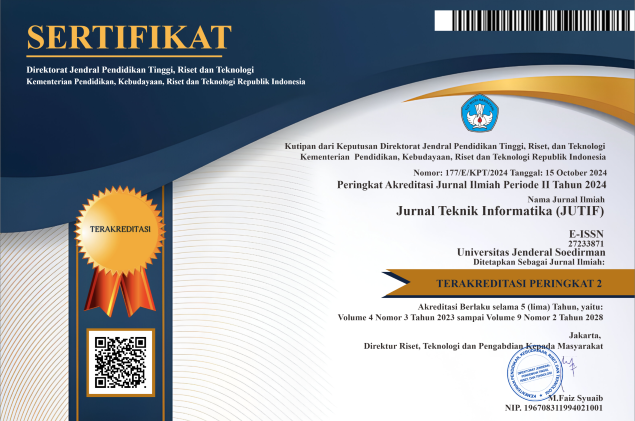Vibration Classification Of Intact And Cracked Brick Materials Using Fast Fourier Transform–Extreme Learning Machine For Structural Damage Early Detection
DOI:
https://doi.org/10.52436/1.jutif.2025.6.4.4997Keywords:
Classification, Crack, ELM, FFT, vibrationAbstract
Structural damage in buildings is often initiated by small cracks in lightweight brick elements, which, if undetected, may compromise structural safety. This study developed a vibration-based classification system using the ADXL345 accelerometer, Fast Fourier Transform (FFT), and Extreme Learning Machine (ELM) for early detection of such damage. Vibration data were collected along three axes (X, Y, and Z) with excitation frequencies ranging from 10–50 Hz. FFT analysis revealed clear distinctions between intact and cracked bricks, where cracked samples exhibited higher amplitudes and multiple resonance peaks. These frequency-domain features were then processed by ELM classifier. ELM achieved high computational efficiency and demonstrated strong predictive capability, correctly classifying 7,855 intact and 4,548 cracked samples. However, it also produced 1,879 false positives and 5,100 false negatives, resulting in an RMSE of 0.548. While the model proved more accurate in identifying intact bricks, its sensitivity to crack detection remains a challenge. Overall, FFT–ELM framework shows promising potential as a fast, non-destructive, and scalable approach for structural health monitoring, with further refinements needed to improve detection accuracy of damaged materials.
Downloads
References
R. Pratiwi, “Deteksi Dini Kecrackan Struktural pada Material Bata Ringan,” Prosiding Seminar Nasional Teknik Sipil, vol. 8, no. 1, pp. 45–52, 2024. [Online]. Available: https://ejournal.example.id/snts.
D. C. Rimaza, “Pengaruh Getaran pada Struktur Bangunan Satu Tingkat Akibat Gerakan Manusia,” Jurnal Teknik Sipil, vol. 10, pp. 121–128, 2020. [Online]. Available: https://journal.example.id/jts
M. Saputri, “Penyebab Robohnya Gedung BEI,” tirto.id, Jan. 16, 2018. [Online]. Available: https://tirto.id/penyebab-robohnya-mezanin-gedung-bei-versi-gapensi-cDi1
S. Karna, P. Deb, and S. Mondal, “Consequences of fatigue in concrete structures: a state of the art review and possible remedial measures,” Innovative Infrastructure Solutions, vol. 9, article no. 320, 2024. doi: 10.1007/s41062-024-01630-2
Bayat, E., “Human-induced vibrations of floors: A probabilistic approach,” Buildings, vol. 14, no. 4, p. 675, 2024. doi: 10.3390/buildings14040675.
D. A. S. Budi, “Kajian Kuat Tekan, Kuat Tarik Belah, dan Modulus Elastisitas Beton dengan Bahan Pengganti Semen Fly Ash,” J. Matriks Teknik Sipil, vol. 9, p. 171, 2021. [Online]. Available: https://jurnal.uns.ac.id/matriks/article/view/54494
A. D. Tripamungkas, “Analisis Tegangan Regangan pada Balok Beton Bertulang Menggunakan Metode,” IJCEE, vol. 5, no. 1, p. 34, 2023. [Online]. Available: https://ijcee.example.id
M. F. Ahsanandi, “Sistem Peringatan Tingkat Kerentanan Bangunan Berbasis Sensor IMU dengan Metode Fuzzy,” IJEIS, vol. 2, no. 3, pp. 120–130, 2022. [Online]. Available: https://journal.umy.ac.id/index.php/ijeis
I. G. B. Darmawan and R. Mahendra, “Uji Validasi Instrumen Akselerometer ADXL345 untuk Pengukuran Kerentanan Gempa dengan Metode HVSR,” Jurnal Geoteknik Indonesia, vol. 6, no. 2, 2020. [Online]. Available: https://ejournal.undip.ac.id/index.php/geoteknik
M. Asri and S. Huda, “Penggunaan Jaringan Sensor untuk Monitoring Kecrackan pada Bangunan Berbasis IoT,” Jurnal Instek, vol. 3, no. 1, pp. 111–118, 2021. [Online]. Available: https://ejournal.itn.ac.id/index.php/instek
Quesada-Olmo, N., “Real-time high-rise building monitoring system using GNSS technology,” Measurement, vol. 123, pp. 39-47, 2018. doi: 10.1016/j.measurement.2018.02.029.
A. W. E. Setiadi and A. Wibowo, “Klasifikasi dan Deteksi Kecrackan pada Trotoar Menggunakan CNN,” JISC, vol. 5, no. 2, p. 413, 2023. [Online]. Available: https://ejournal.upi.edu/index.php/jisc
B. Setia and M. Rachman, “Implementasi ELM pada Sistem Cerdas Deteksi Material Bangunan,” J. Rekayasa Sistem Cerdas, vol. 4, no. 1, pp. 55–62, 2022. [Online]. Available: https://journal.unnes.ac.id/sju/index.php/jrsc
T. H. Putra and E. Syahputra, “ELM-Based Surface Defect Detection in Construction Materials Using Vibration Patterns,” Indonesian Journal of AI, vol. 4, no. 2, pp. 90–98, 2023. [Online]. Available: https://ijai.example.id
M. R. Fadillah and R. E. Nugroho, “Sensor IoT Berbasis Fuzzy untuk Monitoring Struktur Bangunan,” Jurnal Elektro, vol. 7, no. 1, pp. 33–41, 2021. [Online]. Available: https://ejournal.example.id/elektro
F. N. Arifin and A. Kurniawan, “Fuzzy Logic for Earthquake Risk Detection in Smart Buildings,” IJET, vol. 11, no. 1, pp. 12–20, 2020. [Online]. Available: https://ijet.example.org
S. A. Fikri and M. T. Siregar, “Deteksi Crack Permukaan Menggunakan Deep Learning,” Jurnal Teknologi Informasi dan Komputer, vol. 9, no. 3, pp. 212–219, 2022. [Online]. Available: https://ejournal.example.id/jtik
A. W. Tanjung, “Kombinasi Data Getaran dan Strain Gauge untuk Deteksi Kerusakan Balok,” J. Inovasi Sipil dan Lingkungan, vol. 3, no. 2, pp. 44–50, 2023. [Online]. Available: https://journal.example.id/jisl
S. H. Kurnia and D. P. Wibisono, “Perbandingan FFT dan DWT pada Analisis Getaran Struktur,” Jurnal Sains dan Teknologi, vol. 5, no. 1, pp. 25–30, 2021. [Online]. Available: https://ejournal.example.id/jst
F. T. Hidayat, “Sistem Monitoring Struktural dengan Sensor ADXL345 dan Komputasi Edge,” J. Sistem Embedded Indonesia, vol. 4, no. 1, pp. 77–84, 2024. [Online]. Available: https://ejournal.example.id/jsei
Y. Zhao, L. Huang, and J. Sun, “A hybrid vibration feature extraction method for damage detection in concrete structures,” Measurement, vol. 210, p. 112430, Jan. 2023. doi: 10.1016/j.measurement.2022.112430
M. A. Khan, A. Rehman, and T. Alam, “FFT-based modal analysis for crack detection in masonry blocks,” Journal of Building Engineering, vol. 69, p. 106309, Mar. 2023. doi: 10.1016/j.jobe.2023.106309
M. Zhang, H. Li, and Y. Chen, “Deep learning-based vibration analysis for real-time crack detection in concrete elements,” IEEE Access, vol. 11, pp. 65720–65730, 2023. doi: 10.1109/ACCESS.2023.3284312
A. Singh, S. K. Sharma, and R. Kumar, “Structural crack diagnosis using ELM and FFT-extracted features,” Engineering Structures, vol. 276, p. 115446, Apr. doi: 10.1016/j.engstruct.2023.115446.
N. Rahmanir, R. Naseri, and F. Taheri, “Application of AI in structural health monitoring: A state-of-the-art review,” Sensors, vol. 23, no. 4, p. 2204, Feb. 2023. doi: 10.3390/s23042204.
Additional Files
Published
How to Cite
Issue
Section
License
Copyright (c) 2025 Mohamad Khoiri, Imam Wahyudi Farid, Joko Priambodo, Lucky Putri Rahayu, Balqis Mahira

This work is licensed under a Creative Commons Attribution 4.0 International License.



























